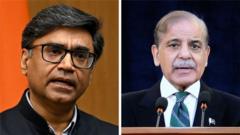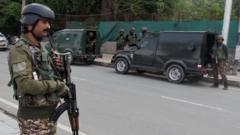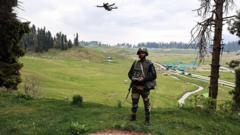The increasing complexity of military technology coupled with resurgent nationalism could lead to more frequent skirmishes in the future.
**Escalation in Kashmir: A New Era of Conflict Between India and Pakistan**

**Escalation in Kashmir: A New Era of Conflict Between India and Pakistan**
Concerns rise as the recent four-day clash signals potential for recurring battles between the nuclear neighbors.
India and Pakistan have once again walked back from the edge of disaster, but the recent chaotic four-day conflict reveals alarming new dynamics in their relationship. Military analysts note that the recent clash was marked by unprecedented aerial warfare characterized by airstrikes, missiles, and a swarm of drones, raising concerns that tensions will escalate further and more regularly in the future.
The skies above the long-disputed region of Kashmir saw a surge in military technology, with both nations employing weaponized drones en masse for the first time. Hundreds operated simultaneously, engaging the defenses of each country without risking pilot lives, introducing a new layer of complexity to the conflict.
The clashes escalated rapidly, with missiles penetrating deep into both nations’ territories and striking critical airbases, prompting heightened military alerts on both sides. Such escalation has raised alarms about the potential for a catastrophic miscalculation. Diplomatically, external intervention, which historically mediated such conflicts, seemed absent or ineffective during this critical juncture.
Srinath Raghavan, a veteran military historian, remarked that past India-Pakistan skirmishes have often been curtailed by timely external interventions, a scenario that seems increasingly precarious. As global leaders grapple with rising tensions elsewhere, the peacekeeping influence that previously mitigated conflict in South Asia appears to be waning.
In a climate defined by aggressive nationalism and military modernization, both nations now find themselves in a precarious situation. The need for renewed dialogue and international cooperation has never been clearer, but the question remains whether either side will avail themselves of diplomatic avenues before the situation deteriorates further.
The skies above the long-disputed region of Kashmir saw a surge in military technology, with both nations employing weaponized drones en masse for the first time. Hundreds operated simultaneously, engaging the defenses of each country without risking pilot lives, introducing a new layer of complexity to the conflict.
The clashes escalated rapidly, with missiles penetrating deep into both nations’ territories and striking critical airbases, prompting heightened military alerts on both sides. Such escalation has raised alarms about the potential for a catastrophic miscalculation. Diplomatically, external intervention, which historically mediated such conflicts, seemed absent or ineffective during this critical juncture.
Srinath Raghavan, a veteran military historian, remarked that past India-Pakistan skirmishes have often been curtailed by timely external interventions, a scenario that seems increasingly precarious. As global leaders grapple with rising tensions elsewhere, the peacekeeping influence that previously mitigated conflict in South Asia appears to be waning.
In a climate defined by aggressive nationalism and military modernization, both nations now find themselves in a precarious situation. The need for renewed dialogue and international cooperation has never been clearer, but the question remains whether either side will avail themselves of diplomatic avenues before the situation deteriorates further.






















